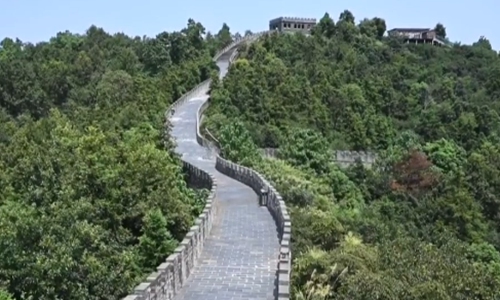Chinese netizens debate over Great Wall replica in E China
By Qi Xijia Source: Global Times Published: 2020/9/9 15:53:40

web
A replica of the world-famous Great Wall built in Nanchang, East China's Jiangxi Province, has gone viral on Chinese social media.
Dubbed by visitors as the "Fake Great Wall", the mock site is a sightseeing walkway in Nanchang Xixiaguaishiling Ecological Park. It is built on a range of hills that stretch four kilometers, with sections divided by watchtowers, just like the "real" one in Beijing.
Some Chinese netizens believed the Great Wall is famous for its historical heritage, which makes a modern copycat like the one in Nanchang meaningless; however, others believed it is fine to take inspiration from the Great Wall if it stimulates local tourism.
"It is a waste of money to make this poor imitation. We have a Great Wall already," commented an internet user named niu.
"How many Great Walls across the country are truly ancient? What you can see at the Great Wall in Beijing is real history. What you have at the Great Wall in Nanchang is convenience to experience the Great Wall without leaving your local city," commented another netizen named xiaolizi.
Other netizens worried the construction of the wall could damage the local ecological environment.
"It could destroy the local ecology and affect the wildlife on both sides of the wall," commented a netizen named caishenjie.
The so-called "Fake Great Wall" was actually built to prevent forest fires, a person in charge of the marketing department of the scenic spot, surnamed Yu, told the Global Times.
"Over 70 percent of the scenic area is woodlands. In order to safeguard tourists and provide them with a more comfortable experience, we decided to build a forest fire barrier imitating the Great Wall," Yu said.
Its construction began in 2013, and was completed in 2018 with over 100 million yuan ($14.6 million) invested.
"We never intended to promote it as the 'real' Great wall. The name actually started from word of mouth by tourists. Most tourists are attracted to our scenic spot by the wall as it can sometimes not be very convenient to go to Beijing," Yu said.
During the May Day holiday, the scenic spot received 40,000 visits, while it had received a peak number of 70,000 visits during other holidays.
The scenic spot now receives 650,000 visits every year, a 10-fold increase since the walkway was constructed.
Yu said that the construction of the "Great Wall" was approved by the relevant authorities, in response to netizens' concerns that it may damage the ecological environment.
"In order to minimize the damage to the nearby forest and plantation during the construction process, we used mules to transport the stones, which prolonged the construction to 6 years," Yu said.
RELATED ARTICLES:
Posted in: SOCIETY